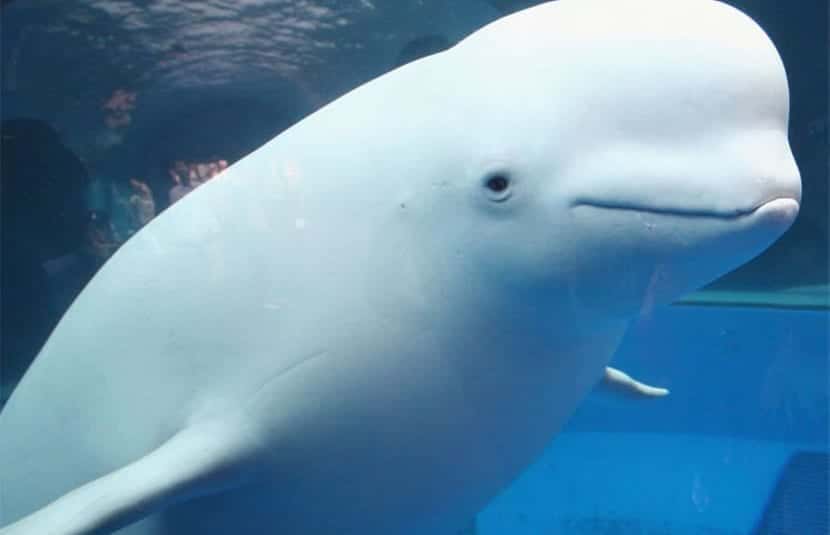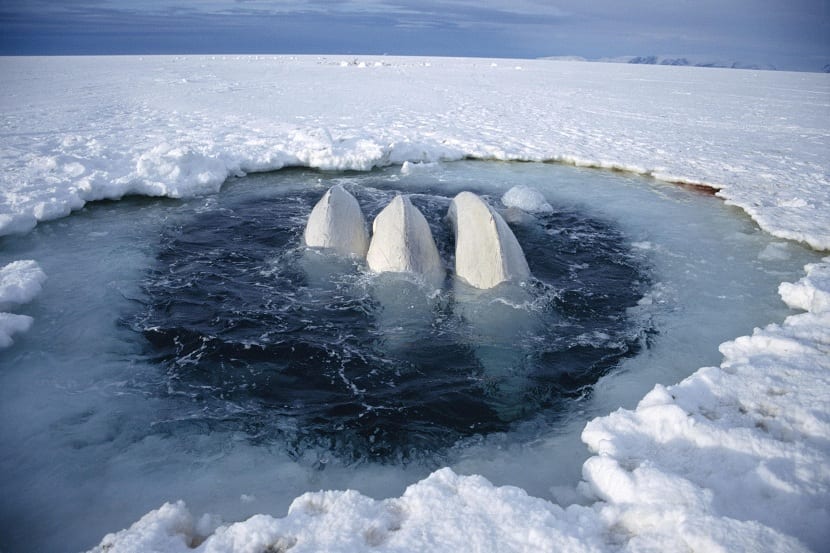
Among the odontocete cetaceans we find the White Whale. Its scientific name is Delphinacterus leucas. The characteristic that stands out the most is the white color of its skin. It is acquired when it has reached maturity. At birth they are gray or even light brown. They also have other special characteristics that we will see in this article and that make them a somewhat curious species.
Do you want to know more about the white whale? Here we tell you everything.
Key features

Among its features that make it different from other whales we have that it does not have a front fin or a bulky and robust appearance. They usually form groups of 10 individuals and in the summer many more get together. Their ability to swim is quite bad, but they make up for it by being able to dive up to 700 meters deep. It is a species with attractive beauty.
Its life span is quite long, reaching the age of 30 approximately. Your age is determined by the amount of cement that forms on your teeth. More or less usually grows two layers of cement a year, so, depending on the layers it has, the age can be estimated more.
Males grow 25% larger than females. They tend to be more robust so they are relatively easily differentiated. They can be between 3,5 and 5,5 meters long, while a female only reaches between 3 and 4 meters. Adult males weigh between 1.100 and 1.600 kilos while females only weigh between 700 and 1.200 kilos.
The white whale has a growing season that lasts until it reaches 10 years of age. Normally at this age they have already reached their maximum size. Being so robust you can see some folds of fat along the belly area. This layer of fat helps them control the temperature in areas of the Arctic where it is colder.
This color tends to change their skin depending on the seasons because it helps them to camouflage themselves with the same color as the snow.
Use of the senses

Another impressive feature of this type of whale is that it has a highly developed sense of vision. Out of the water he can't barely see but in the water he is able to see very well even in the dark.
The eyes are capable of secreting a gelatinous substance capable of protecting it against possible bacteria that can attack it and fungi. In this way, it manages to keep them well lubricated and clean from any external agent. His hearing capacity is also quite high. It is capable of hearing in the range from 1,2 to 120 Khz. Compared to a normal person, it is between 0,2 to 20 Khz.
This whale has a tendency to be able to establish physical contact with other specimens of the same species. This makes us think that their touch is quite sensitive and that they feel safe when they are surrounded by other individuals of the same species. Despite having a layer of fat that protects them, said fat does not make him lose the ability to touch.
Some studies on the white whale have found chemoreceptors on the tongue that make it able to identify flavors through a developed sense of taste. On the contrary, it does not have a sense of smell, as no odor-receiving organs have been found.
White whale feeding

Now we are going to move on to the feeding that this animal follows. The diet that they follow is quite adaptable depending on the areas in which they are. Depending on the levels of food available that we find in the area, it is able to adapt to one menu or another. In their diet they usually consume fish, shrimp, snails, worms, octopuses and other marine animals.
If the food requires it, it can dive deeper and stay for a while without breathing or surfacing for air. Since it has generally quite weak teeth, it eats its prey whole and gradually assimilates them in its stomach. It cannot bite or tear.
This is the reason why white whales they are often a factor in Arctic ecosystems. Since, as we have mentioned before, they tend to walk in large groups, they tend to eat everything around them without any type of filter. This makes the rest of the species suffer from lack of food.
Behavior

Given its morphological characteristics, the white whale does not know anything very well. The body is quite large and bulky and this makes it lose swimming abilities. It is not comparable with the rest of cetaceans or dolphins. Its hydrodynamics do not allow it to move in the water in a fast and agile way.
The maximum speed at which it is capable of swimming is only 9 km / h. This is because its front fins are quite small compared to the rest of the body. As this is the case, it does not have enough pushing force to make the body so bulky able to move.
What does make it special compared to other whales is that it can swim backwards and most of the time they do it in more active waters. They are not as frequent exhibitors out of the water as killer whales and dolphins do because they prefer to be underwater. Although she is considered a bad swimmer, she is considered a good diver. It is able to stay in depths of around 700 meters for even 20 minutes without going out to catch air. There are some observations that indicate that the white whale has been able to descend to a depth of 872 meters.
The muscles of this whale have myoglobin. It is a protein that is capable of transporting oxygen. This protein uses it as an oxygen reserve to be able to dive to such depths.
I hope that with this information you can learn more about the white whale and its way of life.